| Your browser is not supported. | ||
|
Please browse our site using any of the following options:
| ||
Which Kayak Is Best For You?

Whether it's a touring kayak, a fishing kayak or an entry-level recreational kayak, kayaking is an amazing way to enjoy Australia's beaches and waterways. For many people, the appeal of kayaking lies in the calming and meditative aspects of exploring popular beaches or peaceful lakes, streams and rivers at a leisurely pace. For others, kayaking is one of the best ways to get the blood pumping in a full-body workout while making the most of the summer sunshine. Kayaking has also enjoyed an enormous jump in popularity with anglers because it gives you access to sensational fishing spots that you just can't get to by boat or land.
So, no matter how you shake it down, kayaking is awesome fun! To get the most out of your kayaking adventures, it's important to choose the right vessel for your needs. While landing on the best kayak for you might seem a bit overwhelming at first, we've put this handy explainer together to help steer you in the right direction. Getting the best kayak for you also means getting the best value for money - and supercharging the fun!
Quick Links
- Kayaks 101
- How Do You Choose A Kayak?
- The Best Paddles & Accessories For Your Kayak
- Getting Your Kayak To & From The Water
Kayaks 101
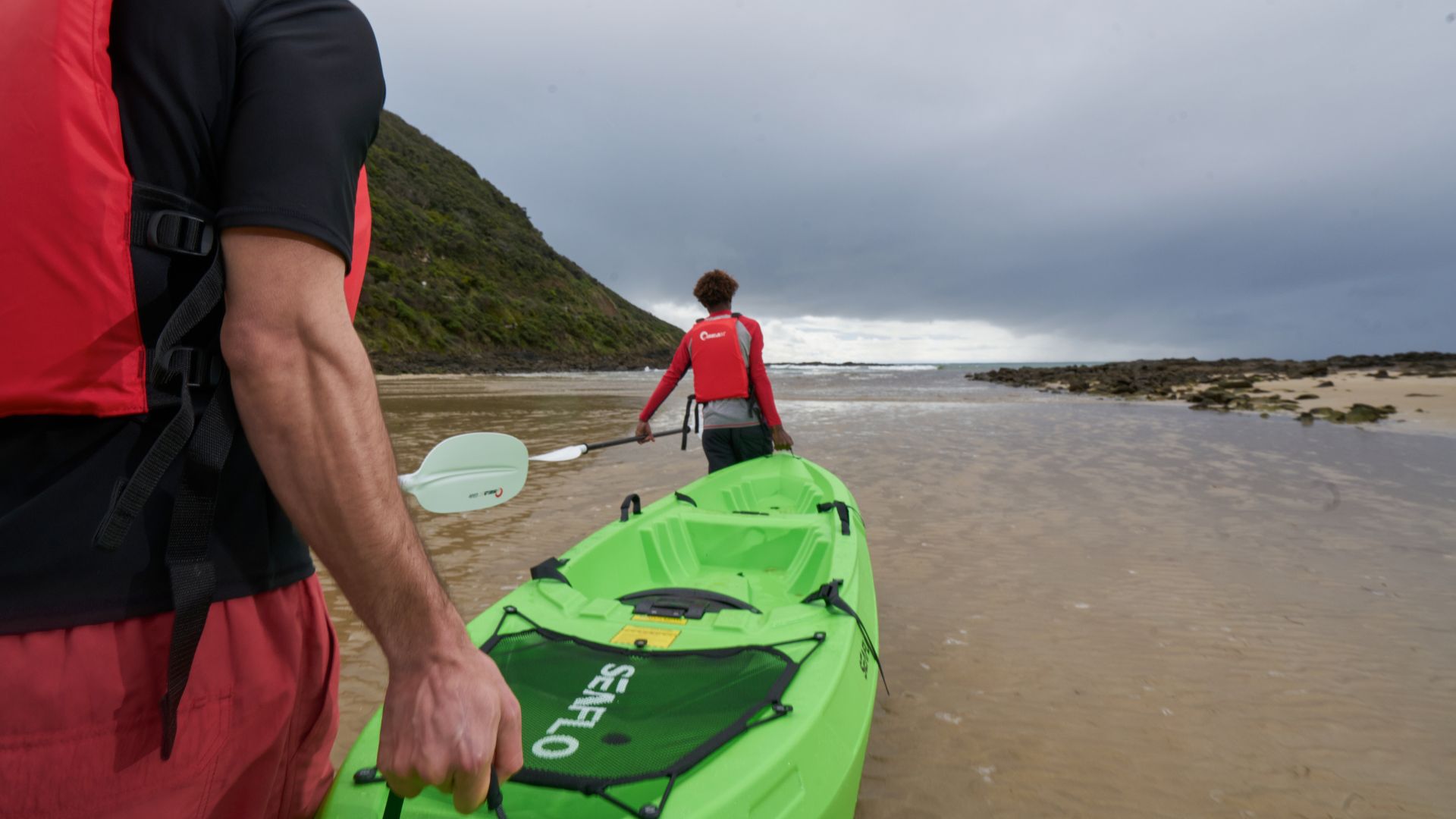
Kayaks are traditionally made from fibreglass, carbon fibre, aluminium and plastic. However, for absolute kayaking beginners, you might like the appeal (and cost!) of an inflatable kayak to see if it's the sport for you before committing too much of your hard-earned cash to more serious equipment. Essentially, there are two basic styles of kayaks: sit-on top kayaks and sit-in kayaks. Understanding the differences between these two styles plays an important role in getting a handle on which is the best kayak for you.
Sit-On Top Kayaks
Sit-on top kayaks live up to their name - you sit, literally, on top of the boat. In most circumstances, sit-on top kayaks are the perfect choice for beginners and kids. These kinds of kayaks are wider than their sit-in counterparts, with the major benefit being their stability, and being easier to get on and off (or in and out of, if you'd prefer to think of it that way). They're also better suited to flatter, warmer and calmer waters, which is why they're considered the best choice for people new to kayaking.
Sit-In Kayaks
Also known as 'touring kayaks', sit-in kayaks have a capsule or 'cockpit' where your legs go inside the hull of the boat to keep you dry below the waist. Narrower and capable of faster speeds in open waters, sit-in kayak models have a more precise centre of gravity in their design, which makes them much more manoeuvrable than a sit-on top kayak. Touring kayaks also usually feature a rudder or skeg (fixed rudder) to enable you to stay on course in rougher conditions. Furthermore, the enclosed hull allows you to store fishing equipment, camping gear or daypacks when you want to get somewhere that the car, 4WD or a bigger boat can't access. Considering this, sit-in kayaks are becoming popular among anglers, which means there are many fishing-specific kayak options now available too.
How Do You Choose A Kayak?
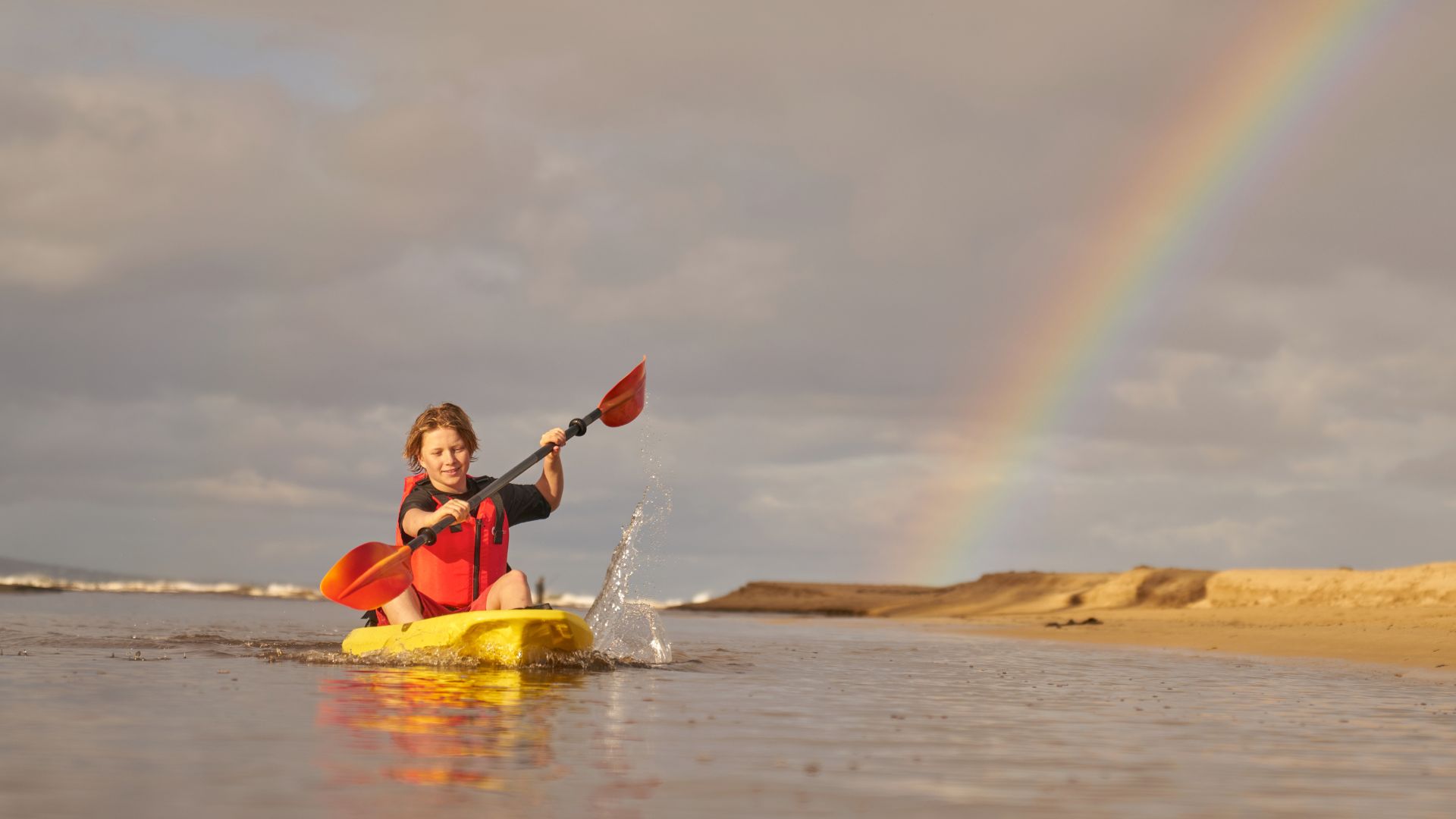
When choosing a kayak, consider your paddling goals, skill level and intended water conditions, such as:
- Purpose: Identify your primary use, such as recreational paddling, touring, or whitewater adventures.
- Type: Choose between sit-on-top, sit-inside, or inflatable kayaks based on your preferences and intended environment.
- Size: Consider the kayak's length for speed, width for stability, and weight capacity to accommodate your body size and gear.
- Material: Evaluate durability and weight by selecting from options like plastic, fibreglass, or composite construction.
- Cockpit Design: Check for comfort, ease of entry/exit, and suitability for your paddling style.
- Seating: Look for adjustable, padded seats and footrests for enhanced comfort during extended paddling sessions.
- Storage: Assess storage compartments and capacity for carrying gear on longer trips.
- Transportation: Consider the kayak's weight and size in relation to your vehicle and storage space.
- Test Paddle: Whenever possible, try out different models to gauge how they handle in the water before making a final decision.
- Budget: Set a realistic budget that aligns with your requirements, considering both the kayak and necessary accessories.
The best kayak for you is likely to evolve over time as your experience develops. A desire to try new kayaking adventures might also influence your choice of kayak. When it comes down to it, though, there's a kayak for all kinds of uses and levels of experience.
If You’re A Beginner
For whatever reason you're thinking of getting into kayaking, the best way to start is with a recreational kayak. The majority of recreational kayaks are sit-on top designs, so their greater stability and handling in more docile waters - like lakes, rivers and calm beach conditions - make them helpful for getting used to staying upright, perfecting your paddling technique and also getting in and out of a kayak safely. Kids' kayaks are basically smaller versions of recreational kayaks and, naturally, a fantastic way to introduce kids to kayaking. They're just as stable, responsive and fun for splashing around on calmer bodies of water as their grown-up versions. Not only that, but kayaks made specifically for youngsters are an affordable way to give your little ones a great experience on the water. Recreational and sit-on top kayaks allow water to splash onto the deck so, in the vast majority of cases, sit-on top kayaks are the better choice for people who only use them in the warmer months. Also, when choosing a sit-on top kayak - no matter what variant you choose or your experience level - always make sure the hull has adequate drainage points so you can stay afloat when you're out on the water. These kinds of kayaks are also the better option for people with minimal paddling experience or those who have a low to reasonable fitness level.
If You're An Intermediate/Advanced Kayaker
If you're a bit more familiar with kayaking than the average punter, you'll have a greater range of kayak choices to weigh up. As well as balancing stability with a narrower hull for increased speed, sit-in kayaks - and the wider range of adventures they make possible - might be calling your name. Sit-in touring kayaks are longer and narrower in design and, because of their speed and greater manoeuvrability, they're better value if you intend on doing some sea kayaking or traversing rapids in fast-flowing rivers. The addition of a spray skirt or spray deck to keep you drier and warmer in colder conditions, makes them perfect for year-round use, no matter what the weather.
If You Want Adventure Of A Different Kind
Touring kayaks are specifically designed for serious long-distance paddling. So, it's not unusual to find these kayaks loaded with (relative!) creature comforts like adjustable seats and footpegs, and plenty of internal storage to accommodate camping gear for longer and more immersive adventures that you might not be able to experience by foot, car, all-wheel drive or boat.
If You Want To Cast Off To The Next Level
Fishing kayaks are becoming wildly popular among anglers, and they're available as both sit-on top and sit-in variations. Sit-on top fishing kayaks are recognisable by their slightly wider hulls for added stability and more freedom to move while fishing. On the other hand, sit-in fishing kayaks boast top-shelf innovations like rod holders and mounts for devices such as fish finders. They also feature plenty of purpose-designed internal storage compartments that can keep your camping gear and accessories separated from the fish you catch, your fishing tackle and other essential angling accessories.
The Best Paddles & Accessories For Your Kayak
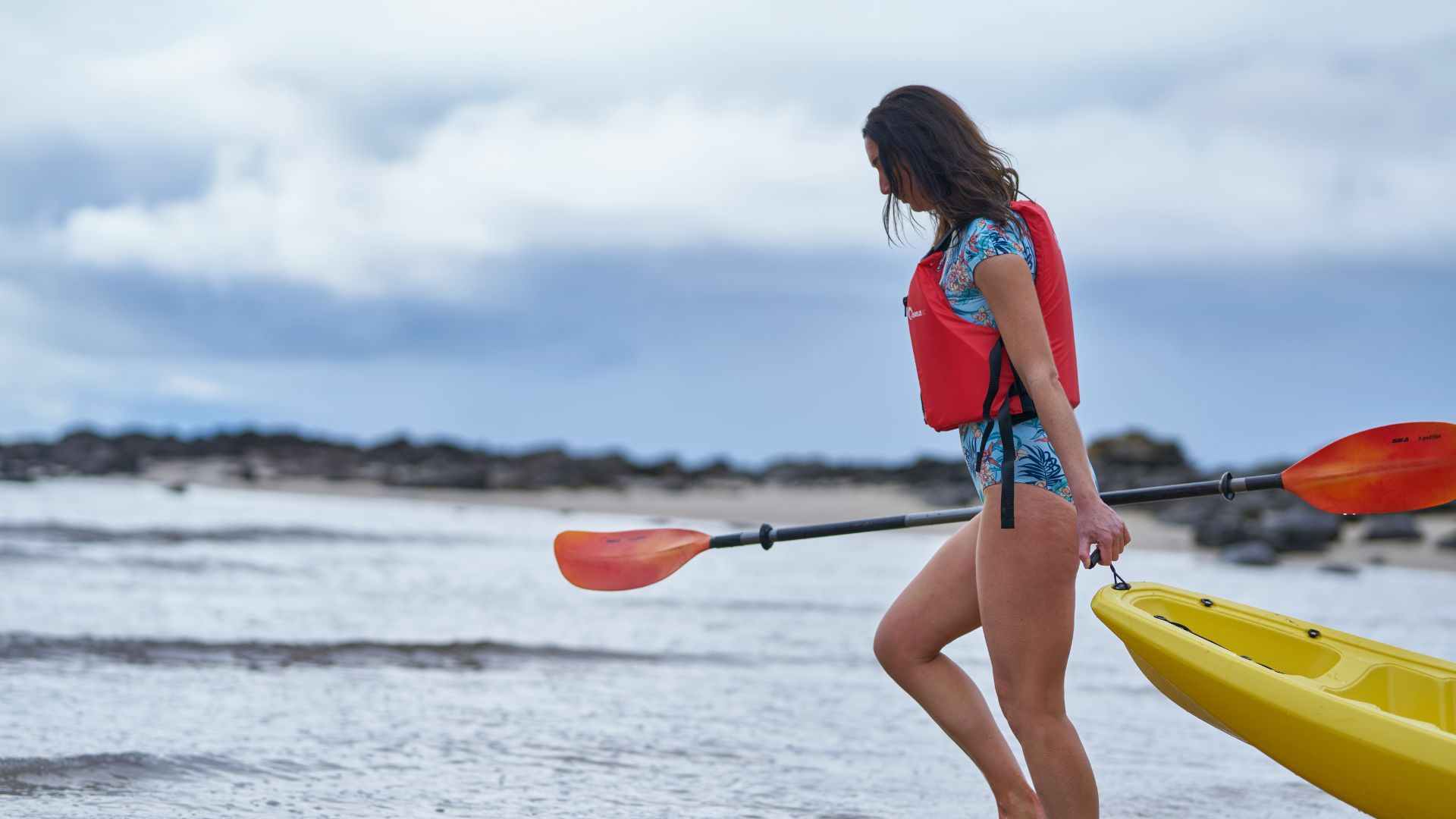
The right kayak paddle makes kayaking an easier, more enjoyable and safer experience - but which one to pick? A lighter paddle could mean your arms will tire too quickly - especially on longer trips. Plastic and aluminium paddles are low in price but tend to be heavier and will drain your energy faster. Comparatively, carbon-fibre paddles are lighter and will provide better value for money over the long term. The best kind of paddle for a beginner is a symmetrical blade with straight sides. Feathered paddles (i.e. paddle blades that face in opposite directions) are a bit pricier, so starting with something basic while you're getting into the swing of things is recommended. Adjustable paddles that can be lengthened or shortened and rotated to suit different conditions - or split in half to make carrying and transporting them easier - are a great option while you're getting the hang of paddling but can involve a little additional maintenance over time.
Depending on what you’re doing, other kayak accessories can include:
- Life Jacket (PFD): Ensure a properly fitting, Coast Guard-approved PFD.
- Safety Gear: Include a whistle, signalling devices, and a first aid kit.
- Spray Skirt: For sit-inside kayaks, a spray skirt keeps water out.
- Dry Bags: Waterproof storage for valuables and essentials.
- Bilge Pump: To remove water from the kayak.
- Kayak Trolley: Eases transportation to and from the water.
- Anchor System: For fishing or stationary moments.
- Navigation Tools: Map, compass or GPS for guidance.
- Kayak Cover: Protects your kayak during storage.
Getting Your Kayak To & From The Water
Most people just want to get on the water when they buy a kayak, so getting it from A to B, and storing it when not in use, can sometimes get overlooked. However, failing to think these things through can take all the fun out of kayaking. Fibreglass, carbon-fibre, aluminium and plastic kayaks are on the larger side, so roof racks and kayak carts and kayak trolleys make getting your kayak to the beach, river or waterway so much easier without breaking the bank (or your back). If you don't have a lot of storage space either at home or in your car, inflatable sit-on top kayaks are a fantastic alternative. Inflating your kayak is easily done thanks to hand pumps and/or a motorised pump that can plug into your car's 12V adaptor. When your paddling is finished, these kayaks quickly deflate to pack away neatly in your car boot and then easily stored when you get home.
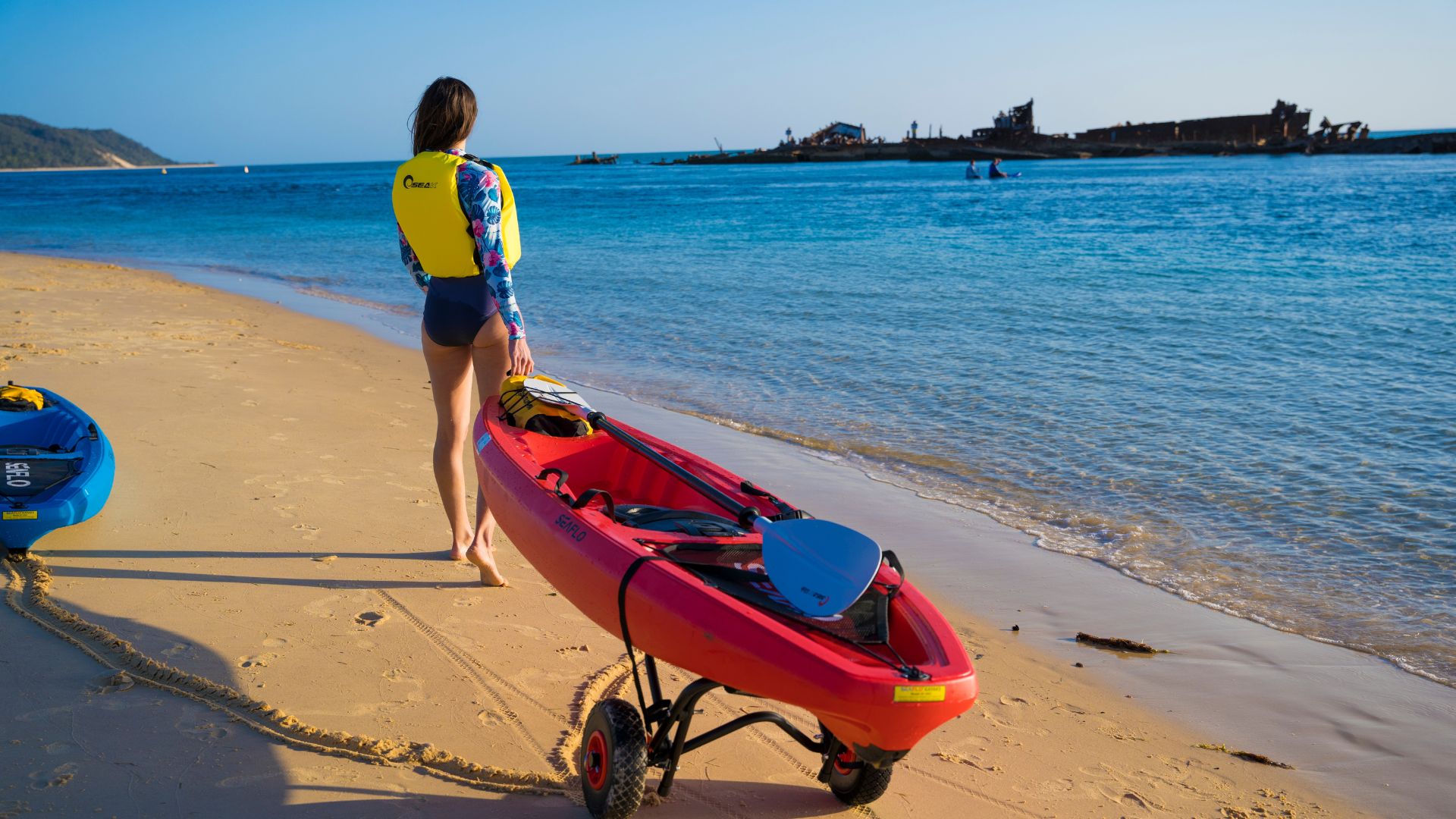
Discover The Best Kayak For You At Anaconda Today
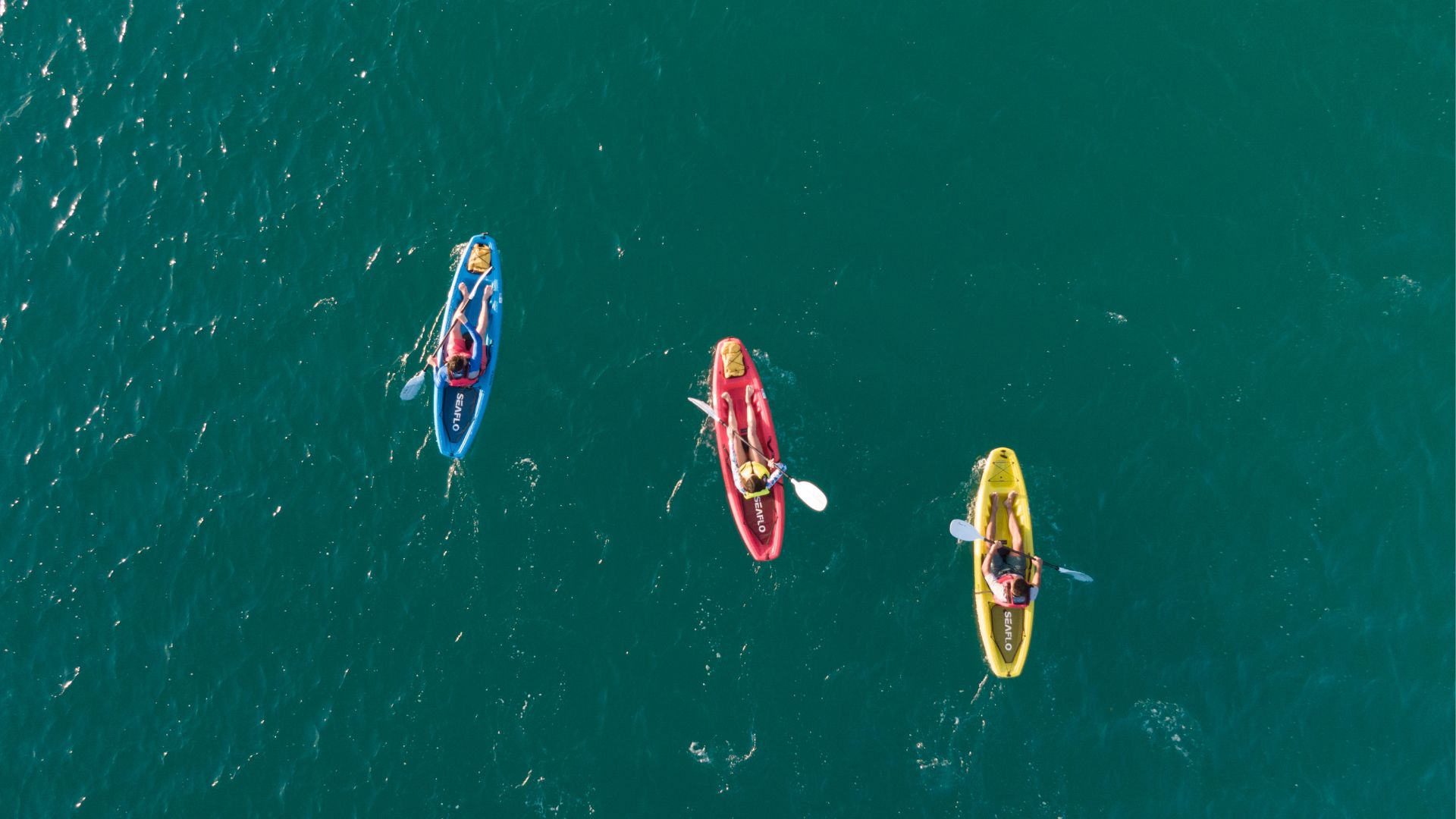
When it comes to buying a kayak, make sure you start by (realistically) knowing your kayaking abilities, the conditions of where you'd like to kayak and what you hope to achieve from your kayaking adventures. Then, you'll be well-positioned to purchase a kayak that is best for you and/or your family. The best kayak for you will deliver outstanding longevity and value for money but, ultimately, help you catch the kayaking bug and understand what all the fuss is about.
Before you head out though, make sure you are fully stocked up on all your water sports gear needs as well as kayaks, paddles, boating accessories and much more. Make sure you check out our Adventure Centre for exciting camping destinations that you can visit with your friends and family. If you liked our helpful tips for camping with kids and children, then you might also like some of our other articles for awesome destinations and tips such as:
- Kayak Buying Guide
- The Best Kayaking Locations In Melbourne
- Australia's Best Kayaking Locations
- How To Get Into Kayaking
Find your local Anaconda store and check out our extensive kayak range for your next outdoor adventure